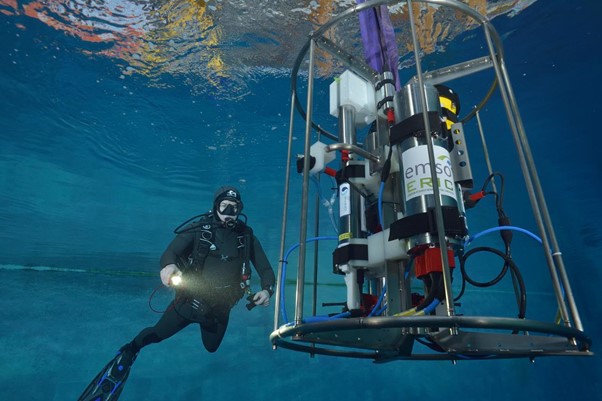A new deliverable report has been published as part of the HORIZON-funded project GEORGE, Next Generation Multiplatform Ocean Observing Technologies for Research Infrastructures. The deliverable 5.1 “Technology validation and prototyping Standard Operation Procedures (SOP) and trials project plan” will be the road map to the integration across the new sensors and platforms, to the deployments at sea planned along the 4 years of the project.
GEORGE brings together 28 leading partners from academia and industry alike, including three research infrastructures: EMSO ERIC, Euro-Argo ERIC and ICOS ERIC. Together these three ERICs cover the whole expanse of European marine waters from coasts to open ocean and from the seabed to the ocean interior and the surface ocean. GEORGE is aimed at improving marine observations in terms of quality, coverage and continuity, through developing novel technologies, particularly autonomous sensors. The new technologies will enable systematic autonomous in situ seawater CO2 system characterisation, and CO2 fluxes on moving and fixed platforms.

The deliverable 5.1 “Technology validation and prototyping Standard Operation Procedures (SOP) and trials project plan” will be the road map to the integration across the new sensors and platforms, to the deployments at sea planned along the 4 years of the project. The first deployments will be stage-gates to monitor the Technology Readiness Level, leading the developments to TRL7 and TRL8 whereas the latest will demonstrate the benefit of GEORGE multi RI context.
We interviewed Nadine Lantéri, co-leader of the national branch of EMSO in France, Regional team leader for the French test site, to discuss the technological challenges and the upcoming deployments in GEORGE.
Can you provide some examples of expected technological developments the project aims to realize?
The developments within GEORGE are numerous and various. They are ranging from cutting-edge equipment and concepts, such as a brand new pH sensors based on spectrophotometry and a promising real time optimisation of the observation strategy using neural network approach, to novel integration of existing devices.
I am especially curious about the final deployment in the Mediterranean Sea when all the platforms, the Sea Explorer glider, the Sailbuoy AUV, the Argo floats, and the EGIM, will operate using the neural network approach!
Developing or upgrading an ocean monitoring system is a long and complex process. What are the main considerations and challenges to take into account for that?
A rigorous test program classically includes functional tests and environmental tests covering the various situations encountered during the entire life cycle: base storage, transport, temporary storage on operation base, transit to operation site, deployment… Each sensor and technology developed in the project are following a testing process starting in the lab, and gradually progressing until the equipment is ready for a deployment at sea, then for commercialisation.
The sea trials are major steps in this maturation process. GEORGE will host more than 8 campaigns across the European Seas, from the Nordic Sea, to the North Atlantic and the Mediterranean Sea. The project will provide a unique opportunity to test the developments at sea and in addition to carry out ambitious deployments involving several teams, various platforms with a large number of sensors on-board in a multi-research infrastructure context involving EMSO, Euro ARGO and ICOS.
You have worked for several years in EMSO on the EGIM. What is the current status of the EGIM and what do you expect by the end of this project?
The EGIM (Lanteri et all., 2022) is EMSO generic equipment designed to measure a set of essential oceanographic variables. It serves EMSO objectives for interoperability, flexibility and capability for future evolution, reliability and data quality. For pragmatist reasons, the design in EMSODEV project was limited to a set of 7 core variables.
GEORGE is the occasion to enrich the EGIM with new sensors and to demonstrate its capabilities in new situations, environmental conditions and deployment mode. We will integrate sensors to measure methane, pCO2, pH, TA and DIC.
We will also fill a gap regarding the deployment mode of the EGIM: we are developing a vector, a lander, to deploy and recover the EGIM from the surface when there is no ROV available on-board.
Among other places, we will deploy the EGIM in the deepest European observation site, PAP (https://projects.noc.ac.uk/pap/) and in very cold conditions on Station M (https://www.uib.no/en/noremso/140162/infrastructure#emso-mohn).
What is the current status of the project on that and what are the next steps?
D5.1 set the basis for the deployment work plan. The multiple deployments will be led by EMSO ERIC, the University of Bergen (Norway) and the National Oceanography Centre (United Kingdom). The first step will be the deployment of an EGIM equipped with a pCO2 sensor in Norway scheduled in September 2024.
Read the full deliverable here.
Photo: Dugornay Olivier (2018). Diving in a test tank for testing the EGIM module. Ifremer. https://image.ifremer.fr/data/00728/83969/
Authors: Sara Pero, EMSO ERIC and Nadine Lantéri, Ifremer


